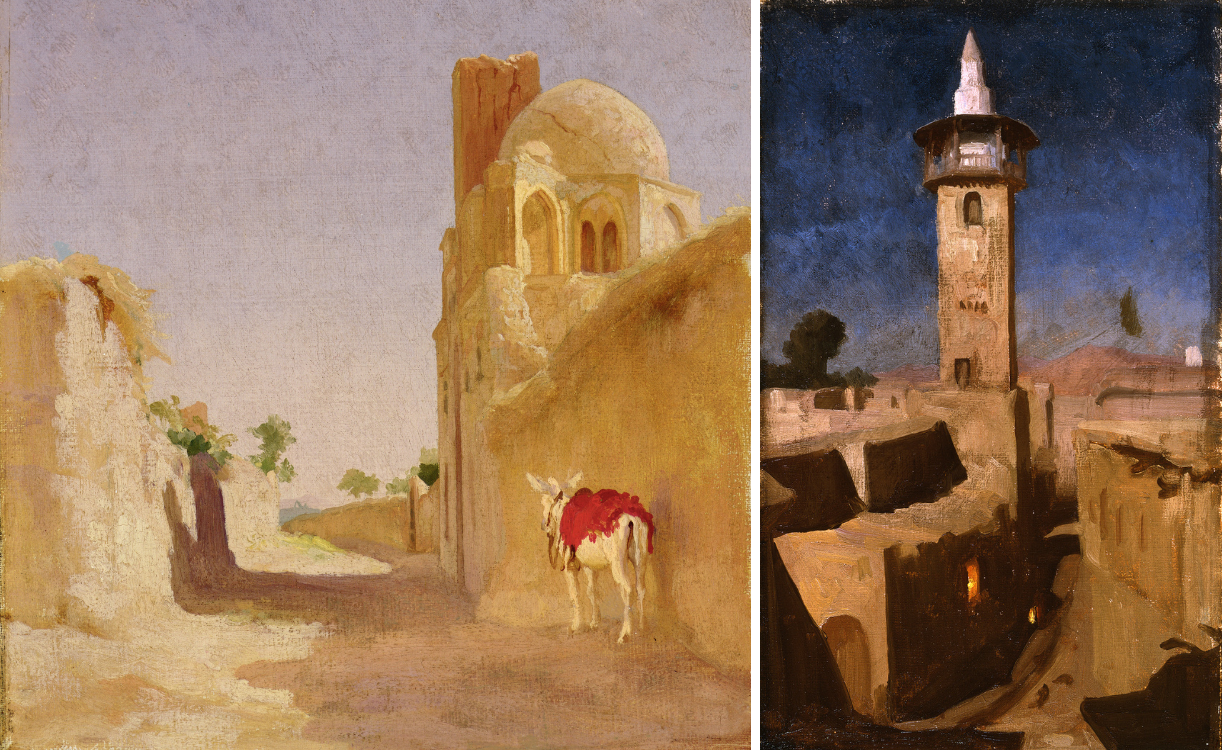Collections highlight: A Damascus landscape
Returning Leighton’s original landscape painting to our collections.
A trip to Damascus
Leighton painted View of Maqam al-Arba’in, Mount Qasioun, Damascus on a trip to the city in 1873. Leighton was a keen traveller and spent part of each year abroad, regularly visiting European countries such as Italy and France, but also venturing further afield to Algeria, Egypt and, in 1873, Syria.
During this trip to Damascus, Leighton stayed with his friend, the explorer, author and diplomat Richard Burton and his wife Isabelle at their home on the outskirts of the city. When Burton moved to Damascus to take up the role of British consul in 1869 Leighton asked him for help with acquiring tiles for his growing collection. Leighton’s trip to the city in 1873 was made with the aim of purchasing further examples and it was on this visit that he bought many of the tiles which would later be displayed in the Arab Hall extension he added to his house in 1877-81.
Shortly after Leighton arrived, he wrote a letter to his father describing his first impressions of the city:
About the town itself as seen from within I have mixed feelings… in architecture, Damascus falls far behind Cairo, both for abundance and beauty of its specimens. It’s background too, Anti-Lebanon, is unsatisfactory, humpy and without power of character or beauty of line… Here, then, are the shortcomings; but I have my compensation in the houses, the old houses of which some few are still standing… are lovely to enchantment.
Painting Mount Qasioun
Despite his initial disappointment with the landscape, Leighton made this small sketch of Mount Qasioun, near to where he was staying with the Burtons. At the centre of the canvas is the Maqam al-Arba’in shrine. Mount Qasioun is an important religious site and is said to be where Cain murdered Abel. In front of the shrine are two lone trees which break up the otherwise scorched brown earth of the mountain. In the foreground a boy admires the view.
Leighton rarely included figures in his landscape studies but may have been inspired by the boy’s clothing. In the letter to his father Leighton noted the local dress, remarking "here you see an extraordinary variety of costumes." He also appears to have brought a number of pieces back, which he later used within his paintings.

Leighton often made landscape sketches as he travelled. Sometimes these would be used within his exhibition pictures, but more often than not they seem to have been produced for rest and relaxation. The sketch of Mount Qasioun is one of three in the Leighton House collection from his 1873 trip to Damascus. A Street in Damascus (pictured left) and Damascus (moonlight) (pictured right) both show views within Damascus itself, but this picture provides a different perspective on the city and Leighton’s experience of it.
As well as capturing the appearance of places he visited, Leighton’s landscape sketches also reveal his interest in different light and weather affects. Across these three Damascus sketches we move from the clear pale sky of View of Maqam al-Arba’in to the bright sunlight of A Street in Damascus, to an inky dusk in Damascus (moonlight).
Restoring Leighton’s original collection
Leighton rarely exhibited or sold his landscape studies, instead retaining them and displaying them on the walls of his studio. A photograph of the space taken in 1895 shows View of Maqam al-Arba’in hanging next to the picture slot alongside other sketches from his travels.
The acquisition of this original landscape painting forms part of the ongoing efforts to restore items from Leighton’s original collection to the house. The museum is grateful to Pola Durajska for her research and assistance with this acquisition.
This painting was purchased with support from the Arts Council England/V&A Purchase Grant Fund and Art Fund.

